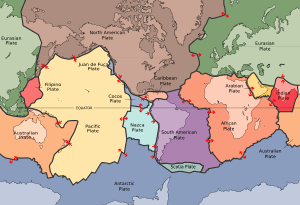Rift (geology) facts for kids
- Further information: Plate tectonics
Imagine the Earth's surface as a giant jigsaw puzzle made of huge pieces called tectonic plates. In geology, a rift happens when these massive plates slowly pull away from each other. This pulling apart stretches and thins the Earth's outer layer, called the lithosphere.
When rifting occurs, it often leads to other exciting geological events. You might see new mountains forming, volcanoes erupting, and earthquakes shaking the ground. As the land stretches and sinks, it can create a long, low area known as a rift valley. Sometimes, these valleys fill with water, forming beautiful rift lakes. A famous example is the Great Rift Valley in East Africa.
A rift is basically what happens when the Earth's crust and lithosphere get stretched and pulled apart. Deep inside the Earth, hot material from the asthenosphere (a softer, flowing layer below the lithosphere) can rise up. This rising hot material helps to thin and stretch the lithosphere even more. Sometimes, this hot material even breaks through to the surface as lava, creating volcanoes.

Contents
What is a Rift?
A rift is like a giant crack in the Earth's surface where the land is slowly splitting apart. Think of it like pulling a piece of dough until it gets thin and eventually tears. On Earth, this happens over millions of years. These rifts are a key part of how our planet's surface changes and moves.
How Rifts Form
Rifts form because of the constant movement of tectonic plates. These plates are always shifting, bumping into each other, or pulling away from each other. When two plates move away, they create tension that stretches the Earth's crust. This stretching causes the crust to become thinner and weaker.
As the crust thins, the hot, gooey rock from the mantle (the layer beneath the crust) can rise closer to the surface. This rising heat helps to weaken the crust even more, making it easier for the rift to grow. Over time, the land in the middle of the rift sinks down, forming a valley.
Types of Rifts
Rifts can happen in different places on Earth. They can form on continents or even under the ocean.
Continental Rifts
Continental rifts are found on land, where continents are slowly being pulled apart. The Great Rift Valley in East Africa is a perfect example. This massive rift system is so big that it's slowly splitting the African continent into two parts. Over millions of years, this area might even become a new ocean!
Continental rifts often have:
- Deep valleys where the land has sunk.
- Many faults, which are cracks in the Earth's crust where rocks have moved.
- Lots of volcanoes, as magma from below finds its way to the surface.
- Frequent earthquakes due to the movement of the land.
Oceanic Rifts
Oceanic rifts happen under the sea, usually along the middle of ocean basins. These are called mid-ocean ridges. Here, new oceanic crust is constantly being formed as magma rises from the mantle and solidifies. The Mid-Atlantic Ridge is a well-known example, running down the middle of the Atlantic Ocean.
Impact of Rifts
Rifts have a huge impact on the Earth's landscape and even on life.
Creating New Landforms
Rifting creates unique landforms. The most common is the rift valley, which can be hundreds or even thousands of kilometers long. These valleys can become home to long, deep lakes, like Lake Malawi in Africa. The pulling apart of the land also leads to the formation of new mountains and hills along the edges of the rift.
Volcanic Activity
Volcanoes are very common in rift zones. As the crust thins, it's easier for hot magma from the mantle to push its way up to the surface. This can lead to spectacular volcanic eruptions, creating new land and shaping the landscape. Iceland is a great example of a country built on a rift, with lots of volcanic activity.
Earthquakes
The constant movement and stretching of the Earth's crust in rift zones cause many earthquakes. These quakes can range from small tremors to powerful shakes, as blocks of land slide past each other along fault lines.
Famous Rifts
- The Great Rift Valley in East Africa is perhaps the most famous. It stretches for thousands of kilometers and is home to many lakes and volcanoes.
- The Mid-Atlantic Ridge is an underwater rift where the North American and Eurasian plates are pulling apart.
- The Basin and Range Province in the western United States is another example of a region shaped by rifting.
Images for kids
-
Topographic profile of the Lake Malawi
See also
 In Spanish: Rift para niños
In Spanish: Rift para niños






